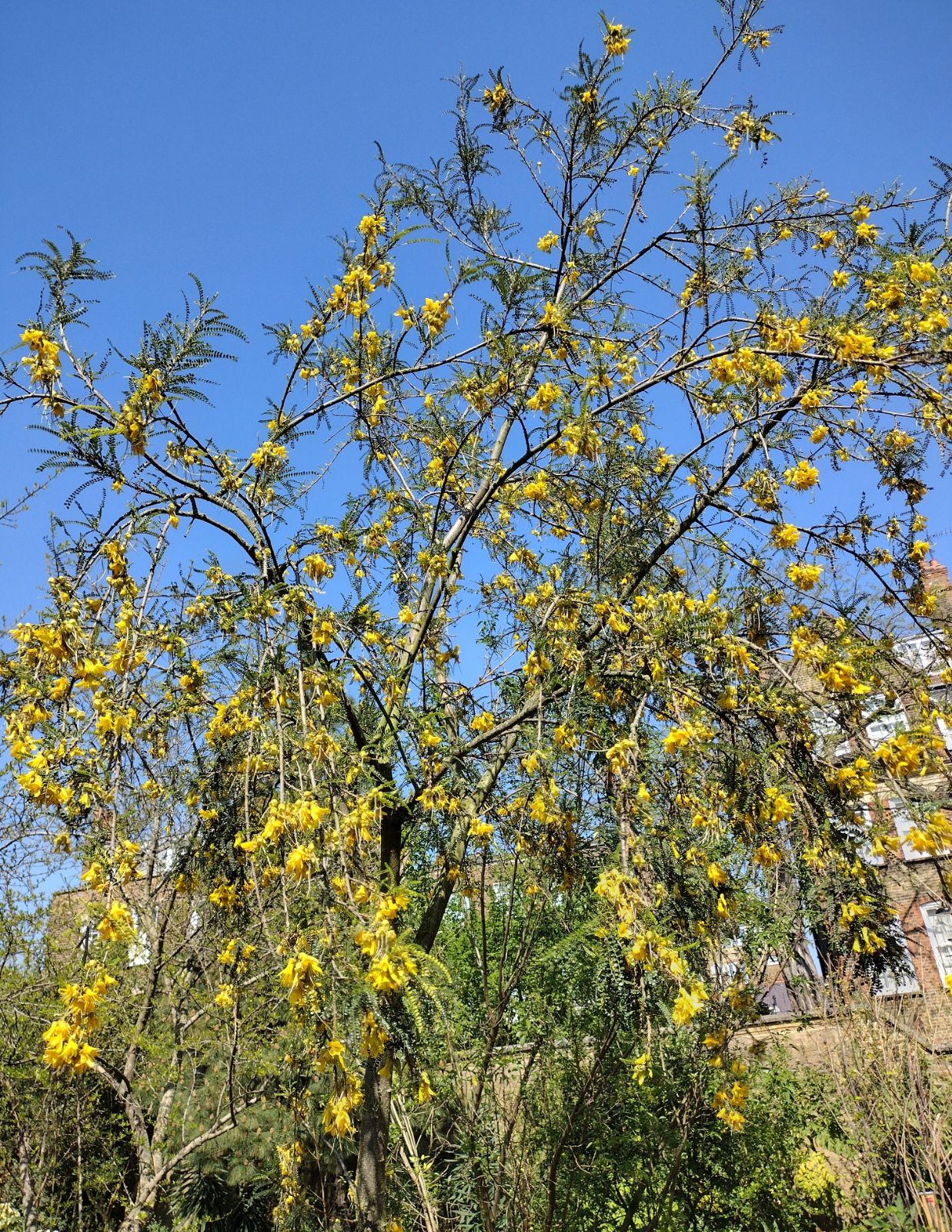Sophora cassioides
Credits
Article from New Trees by John Grimshaw & Ross Bayton
Recommended citation
'Sophora cassioides' from the website Trees and Shrubs Online (treesandshrubsonline.
Shrub or small tree to 16 m; branches sparse and somewhat tortuous. Branchlets covered in ferruginous, silky hairs, later glabrous. Leaves deciduous, imparipinnate, leathery, glabrous above, but with ferruginous hairs below, 4–11 × 1.5–2 cm; leaflets 17–31, subopposite, elliptic to ovate, 0.6–1.1 × 0.3–0.6 cm, apex acute, rounded or slightly notched, margins entire; petiole and rachis contiguous, furrowed above and pubescent; stipules caducous. Inflorescences terminal racemes with three to seven golden-yellow flowers, produced during the emergence of new leaves in spring. Flowers opening widely, with yellow, broadly toothed calyx, petals bright yellow, with standard shorter than wings. Fruit a moniliform legume containing one to six yellow seeds; the swollen seed-bearing portions having four wings with crenulate margins, the pod apex extending into a woody beak to 9 cm long. Flowering August to September (Chile). Gay 1845–1846. Distribution CHILE: from Maule Region south to Chiloé Is.; GOUGH ISLAND (in the middle of the South Atlantic, part of the British Overseas Territory of Saint Helena). Habitat Sandy or loam soils in low-lying areas or hills. Forming pure stands in open forest and shrubland (‘mulga country’), or dominant in mixed vegetation. USDA Hardiness Zone 8–9. Conservation status Not evaluated. Illustration NT789, NT790. Cross-reference B392. Taxonomic note The taxonomy of this species is complex. It was originally described as Edwardsia macnabiana by Graham (1838, 1839), who based his description on cultivated material in Edinburgh, of unknown origin. The species was transferred into Sophora (S. macnabiana (Graham) Skottsb.), but this combination was not validly published. Pelu has also been recognised as S. microphylla subsp. macnabiana (Graham) Yakovlev, but S. microphylla Aiton is now considered to be endemic to New Zealand (Heenan et al. 2001). The correct name for the Chilean Pelu is Sophora cassioides, as established by Heenan (2001).
The confusion of Sophora cassioides with the New Zealand species S. microphylla is perhaps excusable, given that they look very similar and belong to the same section of the genus (Edwardsia). When young, however, S. microphylla has divaricate juvenile growth, later producing mature-phase flowering stems, whereas S. cassioides does not. (There were no moas in Chile!) As mature plants the two differ principally in characters of the leaflets. In S. cassioides these do not usually overlap (though they can do so slightly), are broad in relation to their width, do not taper towards the apex, and are usually glabrous or have only a few appressed hairs. Sophora cassioides forms a small tree with dark green foliage and abundant golden-yellow flowers, followed by attractive four-winged, irregularly shaped fruits. The unselected wild type is sparsely cultivated in our area, but seems to be hardy in southern England and the Pacific Northwest, though usually short-lived. Bean (1981b) records that it was introduced to Britain in 1927 by Harold Comber, but the stock in cultivation has been bolstered by further importations, and seed is freely available in commerce. Sophora cassioides is also cultivated in New Zealand, often under the name S. microphylla ‘Goldilocks’ (New Zealand Plant Conservation Network 2005b) – with risk therefore of contamination of populations of native kowhais. Plants so-labelled are also in cultivation in Europe. Material presumably originating from Gough Island has been distributed as S. tetraptera ‘Goughensis’, but a specimen at the Sir Harold Hillier Gardens acquired in 1989 under this name is S. cassioides. This was 4.2 m tall in 2008, but not looking very healthy.
The tree now very widely propagated and sold as S. microphylla Sun King (‘Hilsop’) originated from material received at the Hillier Gardens in 1982 from Chile. It was selected by John Hillier when it began to flower well, but Allen Coombes has convincingly demonstrated that it is a hybrid between S. cassioides and S. macrocarpa (also from Chile), being intermediate in all respects; another such intermediate has occurred more recently at Hillier Nurseries, in an imported batch of Chilean seed (A. Coombes, pers. comm. 2008). Sun King, which is protected by Plant Breeders’ Rights in Europe and holds an Award of Garden Merit from the Royal Horticultural Society, is marketed as a shrub up to 3 m or so, and seems to be hardy in sheltered sites throughout much of the United Kingdom, producing its rich yellow flowers through late spring. The original tree has reached 3.8 m in height, with a spread of 4 m, supported by several principal stems (A. Coombes, pers. comm. 2008).





